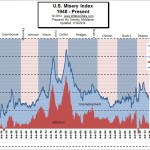The misery index was created by economists in an effort to quantify how bad the economy is based on cold hard numbers. In many ways, it can be argued that suffering is not quantifiable, after all how do you measure the pain associated with starvation, sickness, disease, homelessness, war, lawlessness and all the evils of society? But in economic terms economist Arthur Okun developed a simple but brilliant method of determining how miserable people were economically.
The Misery Index and Unemployment
 The first component is unemployment. Okun reasoned that if a lot of people were unemployed, that would make the country as a whole feel poorer and so they would be less well off. Also a side effect of just knowing that the unemployment rate is increasing is an increase in fear that people might lose their own job as well and this will cause them to cut back on their spending of discretionary items and to save more “just in case”. As a result, more businesses will be hurting from the lack of spending and the suffering will compound.
The first component is unemployment. Okun reasoned that if a lot of people were unemployed, that would make the country as a whole feel poorer and so they would be less well off. Also a side effect of just knowing that the unemployment rate is increasing is an increase in fear that people might lose their own job as well and this will cause them to cut back on their spending of discretionary items and to save more “just in case”. As a result, more businesses will be hurting from the lack of spending and the suffering will compound.
The Misery Index and Inflation
The second component is inflation. Inflation in this case is defined as an increase in prices. The primary cause is an increase in the money supply “Printing Money” at a greater pace than the growth of the “GDP” i.e. Gross Domestic Product. If prices increase more rapidly than salaries individuals will have to reduce their consumption resulting in a lower standard of living.
Calculating the Misery Index
Since both the inflation rate and the unemployment rate are percentages and they each get “worse” as they increase it is a simple matter to simply add the two numbers. Thus if the inflation rate is 3% and the unemployment rate is 6% the misery index would be 9%. Traditionally the it is calculated using the official data from the U.S. Bureau of Labor Statistics and the two exact components are the “Seasonally Adjusted” numbers. So to calculate the official Misery index you would add the Seasonally adjusted CPI-U based inflation rate and add it to the BLS’s Seasonally Adjusted U-3 Unemployment rate.
Misery Index Definition
The definition of the misery index is “A measure of economic well-being for a specified economy, computed by taking the sum of the unemployment rate and the inflation
Misery Index Chart
This index is often presented as a chart. At InflationData we include data not only about the inflation rate, unemployment rate and combined misery index but also the political party of of the President at the time.
Some people prefer to see the actual data and so we also present the historical Misery Index data in table form. Every month we update our current commentary and tell you what it all means. See Current Commentary for a full discussion.
See Also:
- Which Party Has a Better Misery Index Record?
- The Misery Index and the Stock Market
- Producer Price Index (PPI) and Consumer Sentiment Index Point to Deflation
- Inflation Adjusted Stock Prices
- Its Weight in Gold: The Real Prices of Things
- Cost of Living


Leave a Reply